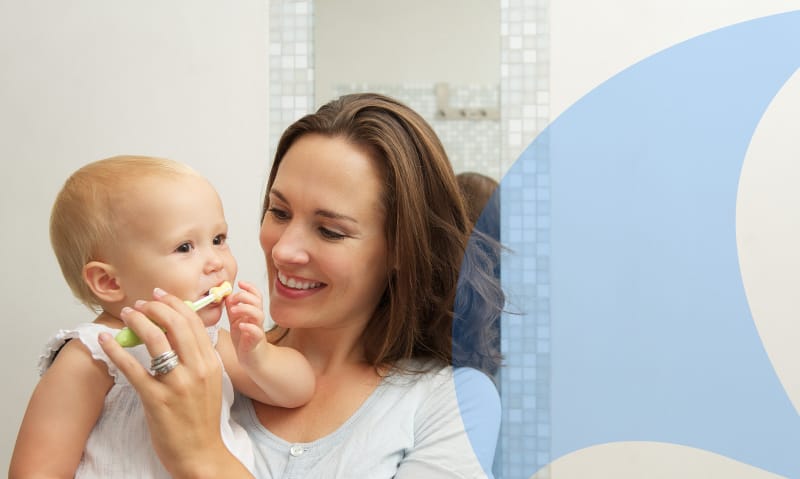6 Things You Need To Know About Brushing Your Baby’s Teeth

As a new parent, it’s only natural that you have questions about taking care of your baby’s teeth. One of the most common questions parents ask is about brushing baby teeth. And it’s a great question because even though your baby’s teeth may seem small and insignificant, it’s essential to take good care of them early to help prevent decay and promote good oral health habits. In this article, we’ll cover six things you need to know about brushing your baby’s teeth, including when to start brushing, how often to brush, what type of toothbrush to use, and other tips for making the process as easy and enjoyable as possible for both you and your little one.
Brushing baby teeth starts on day one!
So your precious bundle of joy has finally arrived. Whether recovering in the hospital from childbirth, or at home, reveling in the joy of your newly adopted child, your minds and hearts are likely full of all the joys, fears, hopes, and dreams new parents face. And in those early days, it’s easy to get sidetracked. Finding time to sleep, eat, and even shower can be challenging for new parents. But one of the things that helps many parents is trying to settle into a routine right off the bat.
Start getting your baby used to toothbrushing as part of that routine. That’s right! Even though your baby won’t likely have their first tooth until around five to seven months, their gums still need your care and attention. Cleaning your baby’s gums every day is soothing, plus helps to establish a routine and focus on oral care, all from the get go. Here are some tips to help you get started.
- Use a gauze pad or a finger brush for their gums. Gently wiping your baby’s gums with a damp gauze pad or a soft finger brush can help remove bacteria and get them accustomed to having their mouth cleaned.
- Brush gently. When brushing your baby’s teeth, use a soft-bristled toothbrush and a gentle touch to avoid irritating their gums or causing discomfort.
- No need to use toothpaste. You can skip the toothpaste until your baby is old enough to spit it out, usually around age two, and just use water to clean their teeth and gums.
Following these recommendations will help your baby get used to the feeling of a toothbrush in their mouth later. If your baby gets used to brushing from the start, they will be able to handle the toothbrush easier as they get older, too. So, consistently introducing brushing and oral hygiene early on can make it a habit and easier for your baby to accept and participate in as they grow.
6 tips to help you get into brushing your baby’s teeth.
Let’s explore six helpful tips for brushing your baby’s teeth to make it more manageable and effective. From the best tools to the proper technique, these tips will help ensure your baby’s teeth and gums stay healthy and clean. Here are some things to keep in mind:
1. Brush your baby’s gums after each feeding.
Wiping your baby’s gums with a clean, damp cloth after feeding can help remove bacteria and promote good oral health habits. Not only that, but many babies find this a relaxing process, so consider it a great part of your daily bonding time!
2. Toothbrushing can begin the day your baby’s first tooth pokes through.
Once your baby’s first tooth emerges, it’s time to start brushing with a toothbrush designed specifically for children. Be sure to brush your child’s teeth gently twice daily, in the morning and at night, or as directed by your dentist.
3. You can use a soft finger toothbrush to clean.
A finger toothbrush is an excellent option for cleaning your baby’s teeth and gums, and it can be gentler than a traditional toothbrush. If you don’t like using your finger, you can also try using a three-sided toothbrush or gauze to clean your baby’s gums and teeth.
4. Try a soft gauze or washcloth if your baby seems sensitive to the toothbrush.
Some babies may find a toothbrush uncomfortable initially, so try using a soft gauze or washcloth instead. And if your baby pushes back, don’t fret. Take a break and try again later. Be persistent, but gentle and patient.
5. Only dispense a rice grain-sized amount of toothpaste.
When your baby is old enough to use toothpaste, use a small amount—about the size of a grain of rice—and avoid toothpaste with fluoride until your child is old enough to spit it out. Toothpaste caps can also help dispense a small amount of toothpaste. And don’t forget about flossing. Once your baby has two teeth that touch, it’s time to start flossing to remove food particles and bacteria between the teeth.
6. Allow your baby to participate with brushing from the beginning.
Letting your baby hold and play with the toothbrush can help them become more comfortable with the process, just be sure to supervise and never let your toddler run around with a toothbrush—that can be hazardous if they fall. It is best to have babies sit on your knee with their head resting against your chest, or in your lap, to make brushing easier and more comfortable for both of you.
Brushing baby teeth early sets your baby up for oral health success.
Now that you have some helpful toothbrushing tips, you are on your way to setting your child up for oral health success. But remember, if the toothbrushing process isn’t going well or you have questions, your baby dentist in Salem is here to help. You can reach out anytime if you have questions or if it is time for that first appointment. Request an appointment today.